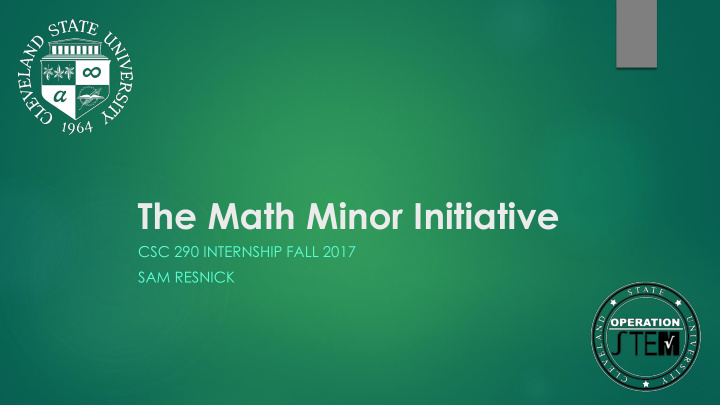



The Math Minor Initiative CSC 290 INTERNSHIP FALL 2017 SAM RESNICK
About Me I am OpSTEM Intern. I am currently studying Chemistry at CSU. I also work at Target in the electronics department. My beard is naturally 3 different colors.
History of Math Minor Initiative CSU Mathematics professor, Dr. Carol Phillips-Bey, realized that the required math courses for engineers could easily apply toward a minor in Math. Dr. Phillips-Bey also saw student lack of knowledge regarding how to obtain the Math minor and informed Dr. Susan Carver. Internship position created to educate engineering students on what they could achieve.
Overview of Math Minor Initiative Increase the number of engineering students with Math Minors by at least 100 by end of Fall 2017. Reach out by data sorting, personalized emails, Degree Maps, Math Minor flier and class visits. Document steps taken in order to replicate procedures, communication method and results. Evaluate approach and return on investment.
Timeline of Declared Math Minors Pre-Initiative 49 Math Minors as of February 13, 2017 142 as of August 16 th Post-Initiative 195 as of October 13 th - My direct contact began 251 as of November 27 th
September – Planning & Data Sorting Decided on a plan of attack to get the information out to the students. Started with sorting tables of data describing students’ majors and tailoring emails for each engineering major.
October – Personalized Emails Established focus of Earn a Math Minor email and its contents. Sent personalized emails via mail merge to each student based on course and engineering major. Emailed all Fall 2017 Calculus I and Calculus II engineers (N= 243)
November – Class Visits For each class, personalized CSU Degree Maps and the document to the right were distributed to each engineering major. Using these documents and OpSTEM kindles, Dr. Carver and I visited Calculus I and II OpSTEM sections to explain how to earn a math minor.
Return on Investment Initial # of Final # of Gain Time Frame Possible Reasons of Increase Math Minors Math Minors Educated First Year and OpSTEM 49 142 93 28 weeks Advisors and OpSTEM Summer (2/13/17) (8/16/17) Calculus I Students First Year Advisors, 2017 OpSTEM 143 194 51 8 weeks Summer Institute Scholars, Word of (8/16/17) (10/13/16) Mouth Math Minor Initiative In-class Presentations and Emails, First 195 251 56 6 weeks Year and OpSTEM Advisors (10/13/17) (11/27/17) Advocates, Word of Mouth
What I Learned from CSC 290 and Applied to the Project Setting small scale goals makes a larger goal much more approachable and creates clear separation of work. Constant communication with a supervisor or peer in the program will offer new ideas on how to tackle problems. Weekly assessment meetings make it easy to stay on track and show progress on smaller goals.
Challenges Branching out to other classes may require involving more people. Answering students’ questions before they sign -up is time consuming. Students need individual walk-through of steps. Finding more efficient ways to educate and reach out to students.
Solutions Acquiring more people to help personally reach out to all engineering math courses and Calculus III. Explaining to advisors about math minor and communicate frequently, i.e., provide updates. Setting up a table at the Engineering Career Fair, post fliers around campus especially throughout the engineering buildings, continue to educate the First Year and enigineering advisors.
Next Steps Follow- up with students who have received information, yet haven’t acted. Continuing with class visits until we find a more efficient way to get students’ attention to act. Branching out to higher level math classes and engineering equivalents. Ensuring math classes have enough sections to accommodate the influx of new Math Minors.
Questions?
Thanks I would like to dedicate this slide as thanks to following people: Dr. Susan Carver for her guidance and insight into how-to of this project. Juan Amador, who gave technical advice and helped create multiple materials for the Initiative. Hyacinthe Raven who is in charge of the course and who provided excellent soft skills activities. Everyone who attended this presentation and listened.
Recommend
More recommend